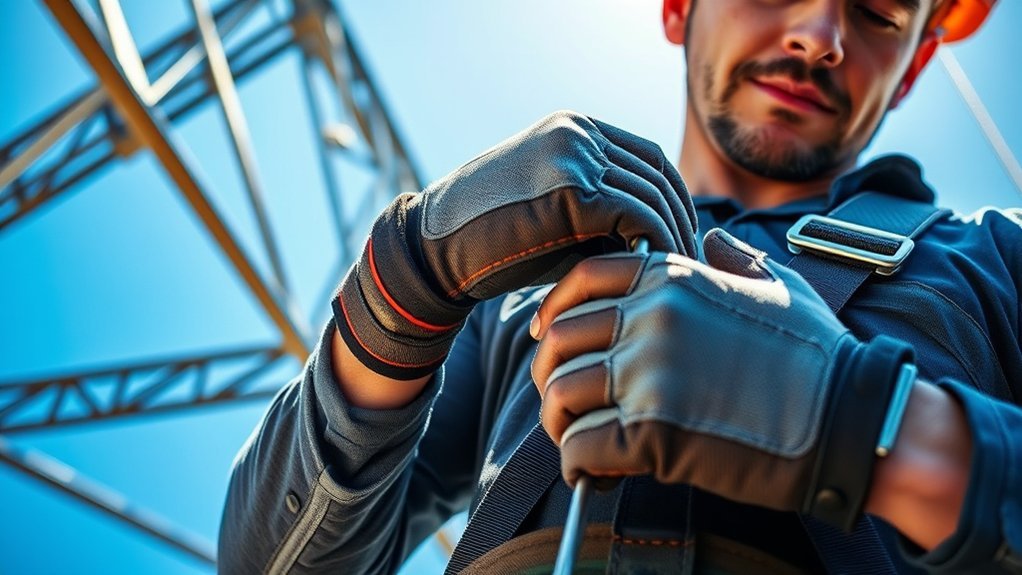Harness fit is critical to safety in climbing and working at heights. Improper sizing and adjustments often stem from user error and environmental influences. You might overlook manufacturer guidelines, leading to potential hazards. Understanding the causes and risk factors is essential for effective risk management. But what specific practices can enhance safety and guarantee proper fit? Exploring these elements can provide the insights needed to mitigate risks effectively.
Understanding Harness Fit and Its Importance
When you understand harness fit, you can greatly enhance both safety and performance in various activities, such as climbing or working at heights. A well-fitted harness distributes weight evenly across your body, minimizing pressure points and reducing the risk of injury.
To guarantee ideal fit, adjust the shoulder straps, leg loops, and chest straps according to your body size and shape. Inspect the harness regularly for wear and damage, as even minor issues can compromise safety.
Pay attention to the harness’s positioning; it should sit high on your hips and snugly against your torso. By prioritizing proper harness fit, you not only improve comfort but also increase your stability, enabling better control during dynamic movements in challenging environments.
Common Causes of Improper Harness Fit
Improper harness fit often stems from a combination of factors that can greatly impact safety and performance. One primary cause is incorrect sizing, where the harness doesn’t match your body dimensions. Additionally, improper adjustments can lead to slack or excessive tightness, compromising function. Material wear and tear can also affect fit; frayed straps may not hold securely. Finally, user error—such as neglecting to follow manufacturer guidelines—can result in inadequate fit.
| Cause | Impact | Prevention |
|---|---|---|
| Incorrect sizing | Reduced safety | Measure before use |
| Improper adjustments | Reduced performance | Regularly check fit |
| Material wear | Increased risk of failure | Replace worn equipment |
| User error | Unsafe conditions | Follow guidelines closely |
Identifying Key Risk Factors
How can you effectively identify risk factors that contribute to improper harness fit? Start by examining the user’s physical attributes, such as body shape and size, which can considerably influence fit.
Next, assess the harness design—features like adjustability and material can either enhance or hinder proper fit.
Additionally, consider environmental factors, such as temperature and weather conditions, which may affect the harness’s performance.
Regularly evaluate the usage patterns, including how often the harness is worn and under what conditions.
Finally, gather feedback from users regarding comfort and fit issues.
The Role of Training and Education
Although many factors contribute to proper harness fit, effective training and education play an essential role in mitigating risks. Understanding the intricacies of harness fit guarantees you’re equipped to make informed decisions. Training programs should focus on the following critical aspects:
| Training Component | Description | Impact on Safety |
|---|---|---|
| Harness Selection | Choosing the right equipment | Reduces fitting errors |
| Adjustment Techniques | Properly fitting the harness | Enhances comfort and safety |
| Inspection Protocols | Regular checks for wear and tear | Prevents equipment failure |
| Compliance Education | Understanding regulations | Minimizes legal liabilities |
Best Practices for Equipment Maintenance and Safety
To guarantee ideal performance and safety, it’s essential to implement best practices for equipment maintenance.
Regularly inspect your harnesses and associated gear, focusing on wear and tear, frayed straps, and hardware integrity. Document these inspections and maintain a maintenance log to track issues and resolutions.
Clean your equipment according to manufacturer specifications, using appropriate cleaning agents to avoid damage. Ascertain that all components, including buckles and D-rings, function correctly and replace any defective parts immediately.
Additionally, store harnesses in a dry, cool environment to prevent degradation.
Finally, conduct routine training sessions to reinforce proper usage and care among users, minimizing risks and enhancing safety.
Adhering to these practices guarantees equipment longevity and peak performance.
Frequently Asked Questions
What Types of Harnesses Are Best for Different Activities?
For rock climbing, use a sport harness; for hiking, consider a padded, breathable model; for dog walking, opt for an adjustable harness. Each activity requires specific features to enhance safety and comfort effectively.
How Often Should Harnesses Be Inspected for Fit?
You should inspect harnesses for fit every time you use them, as studies show improper fit increases accident risk by 50%. Regular checks guarantee safety and performance, adapting to changes in body shape or wear over time.
Can Improper Harness Fit Cause Long-Term Health Issues?
Yes, improper harness fit can lead to long-term health issues. It may cause chronic pain, restricted movement, or circulatory problems. Regular assessments guarantee your harness supports your body effectively, minimizing these potential health risks.
Are There Specific Brands Known for Better Harness Fit?
Yes, specific brands like PetSafe, Kurgo, and Ruffwear are recognized for better harness fit. They prioritize adjustable designs and ergonomic features, ensuring a secure fit that enhances comfort and reduces potential long-term health issues for pets.
How Do Weather Conditions Affect Harness Fit and Comfort?
Weather conditions can considerably impact harness fit and comfort. For instance, humidity may cause materials to stretch or cling, while cold temperatures can lead to stiffness, affecting overall adjustment and wearability during outdoor activities.
Conclusion
So, if you enjoy the thrill of dangling precariously from a height, by all means, ignore harness fit! Just remember, a harness that’s too loose might as well be a fashionable accessory for your next fall. But if you’d rather keep your feet on solid ground, pay attention to sizing, adjustments, and maintenance. After all, a well-fitted harness isn’t just about looking good; it’s your ticket to safety. Choose wisely, or you might just become a cautionary tale.
